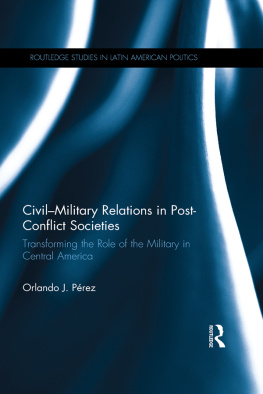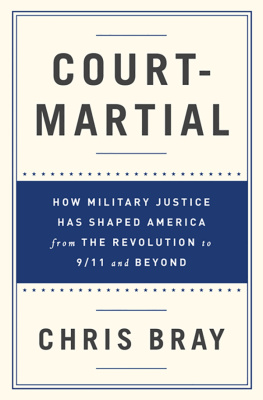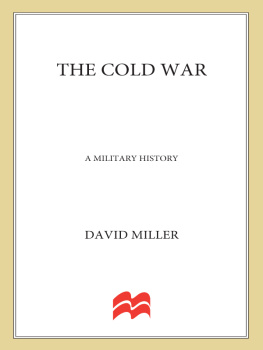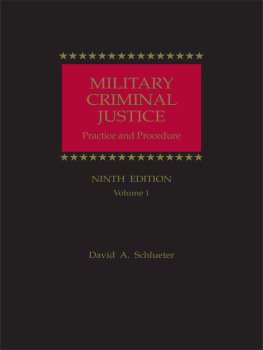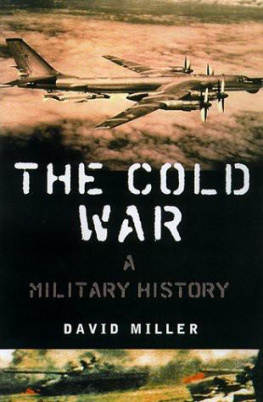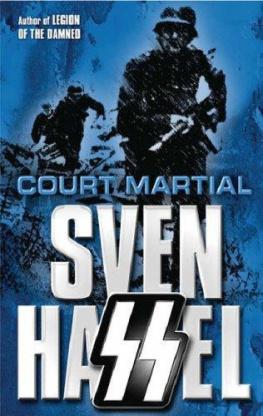Copyright 2005 by Princeton University Press
Published by Princeton University Press, 41 William Street, Princeton,
New Jersey 08540
In the United Kingdom: Princeton University Press, 3 Market Place, Woodstock,
Oxfordshire OX20 1SY
All Rights Reserved
Library of Congress Cataloging-in-Publication Data
Hillman, Elizabeth Lutes, 1967
Defending America : military culture and the Cold War court-martial / Elizabeth Lutes Hillman.
p. cm. (Politics and society in twentieth-century America)
Includes bibliographical references and index.
ISBN 0-691-11804-3 (alk. paper)
1. Courts-martial and courts of inquiryUnited StatesHistory20th century. 2. Courts-martial and courts of inquirySocial aspectsUnited StatesHistory20th century. 3. Sociology, MilitaryUnited StatesHistory20th century. 4. Cold warSocial aspectsUnited States. I. Title. II. Series.
KF7620.H55 2005
343.73'0143dc22
2004058962
British Library Cataloging-in-Publication Data is available
pup.princeton.edu
eISBN: 978-0-691-22426-8
R0
INTRODUCTION
T his is a book about the American military, its system of justice, and its criminals. It tells of ordinary mistakes and extraordinary violence, of what happened when things went wrong as the Cold War military defended an anxious nation. The military criminals of the Cold War were deserters, rapists, spies, and bigamists. They included a company commander, one of very few African American officers, sentenced to death by a panel of white officers for refusing to advance on a Korean War battlefield; a much-decorated, long-retired admiral spied upon in his San Diego home and then court-martialed for being gay; a petty officer prosecuted for unauthorized absence after going home to Virginia to care for his ailing mother; a private, angry at his Vietnamese girlfriend for her attentions to other GIs (she was a prostitute), convicted for shooting and killing her. These crimes offer a glimpse into the internal world of military service in the decades after World War II, when a fierce battle to preserve a cherished culture was waged against the encroachment of class, racial, and sexual diversity. Hardship and violence, humor and romance, the harsh reality of military service and the awkward process of enforcing law during war: all were part of American military justice. The court-martial exposes the fault lines of the United States during the Cold War, when demographic change and legal reform made the state of the armed forces a telling echo of the state of the nation.
Yet military justice has been almost completely overlooked by scholars of American history and law. As a body of law and as a source of history, military justice has been doubly neglected.
This book remedies that neglect. It uses court-martial records to deepen our understanding of how criminal justice worked, how servicemembers lived, and why legal reform mattered in the postWorld War II United States. This is a study of Cold War military justice not because it covers every year of the conflict or because it details every shift in foreign and military policy. The social orders that had regulated American military life were suddenly fragile.
The court-martial registers the insecurity of the Cold War years in especially vivid fashion. A key part of that insecurity was the conflict between legal and political principles in the governance of the armed forces, apparent throughout the process of military justice. Asked to preserve the freedom of American citizens, the armed forces were starkly undemocratic, composed of many nonvolunteers and governed in authoritarian fashion. If the great political divide of the Cold War years was the Soviets dependence on coercion versus the Americans emphasis on consent, then the mere existence of the U.S. military disrupted a simple narrative of West versus East. Nowhere was the tension between military tradition and liberal democratic values more apparent than at court-martial, where the Cold War armed forces punished the gravest violations of military rules and regulations. The military prosecuted men who refused to defer to superiors, who spoke out against the war in Vietnam or in favor of communism, who got married without permission or had homosexual affairs. The militarys separate criminal justice system, improved but preserved by postWorld War II reforms, put those who fought to protect the U.S. Constitution beyond the reach of some of its most basic protections. And until the end of the draft in 1973, many Americans in uniform served reluctantly, compelled to join the military not by a sense of duty but by force of law.
This book traces the ways in which legal reform progressedand falteredin a particularly telling arena of criminal justice and social control. Its chapters explore the conflicts that divided the armed forces, and the nation, during the Cold War. The tension between the authority granted commanding officers and the process due at court-martial, along with the clash between the militarys increasing heterogeneity and its commitment to an exclusive, archaic culture, tested the very structure of the American military. Protecting individual rights, both in the United States and around the world, became a higher priority in the 1950s and 1960s, colliding with the military practice of enforcing conformity and imposing involuntary service. In this era of political strife, conscription, and war, legal reformers tried to standardize the definition of military crime and regularize its prosecution. They hoped to bring justice to American citizens in uniform much like those uniformed troops hoped to bring freedom and prosperity to the United States allies around the world.
From the advent of a reformed military justice system in 1951 until the end of the Vietnam War, millions of Americans stood accused before military courts, charged with crimes defined by their commanders and tried according to special procedures set out in the Uniform Code of Military Justice (UCMJ). The previous regime of military law had been attacked as harsh and unfair during World War II, leading veterans and politicians to demand change. As a result, Cold War troops, whether charged with going AWOL, disobeying orders, or frequenting gay bars, had greater legal protections than had earlier generations of American soldiers. But because the UCMJ granted commanding officers broad discretion to define crime and control its prosecution, the success of its reforms was sharply limited by the military culture in which courts-martial took place.
At the same time that statutory reform brought new standards of justice to military criminal procedure, the military itself grew in authority, significance, and visibility. Until after World War II, the United States military was small and isolated except in times of war.
This convergence of American and military culture was also reflected in the diminishing gap between military and civilian justice during the Cold War. Both changes echoed the shift toward specified crimes and higher procedural standards that occurred in many civilian criminal jurisdictions.
But procedure could not keep cultural norms from influencing the outcomes of either military or civilian criminal trials and appeals. Military criminal records document the continuing impact of racial prejudice, socioeconomic distinctions, and assumptions about gender roles and sexual behavior on the process and outcomes of American criminal justice after World War II. The court-martial reveals that defending America involved not just fighting wars, but policing the political ideologies, sexual intimacies, and social interactions of the nations citizen-soldiers. Official pronouncements declared equality of treatment across race lines, but racism in personnel policies, criminal justice outcomes, and portrayals of enemy forces continued. Recruiters were desperate to find competent troops but ignored women as a viable resource. The military forbade homosexuality but mandated same-sex environments, lionized sexual vigor but touted sexual restraint. The armed forces also participated in the widespread political repression that characterized American political culture during this period. The need to identify and eliminate communists was of paramount importance within the armed forces, where disloyalty could directly undermine national security interests. The possibility of subversion from within the ranks of the military was a particularly galling thought to citizens already wary of the burgeoning Department of Defense. Military courts struggled to balance demands for reform and democratization against a long-standing culture of masculine privilege, racial exclusivity, and authoritarian leadership. Military justice reveals the power and depth of that struggle. It demonstrates not only how judges and judge advocates resolved legal issues and how politics and culture influenced military leaders, but also how soldiers on the ground lived out the conflicts created by the United States role in fighting the ideological and actual battles of the Cold War.


